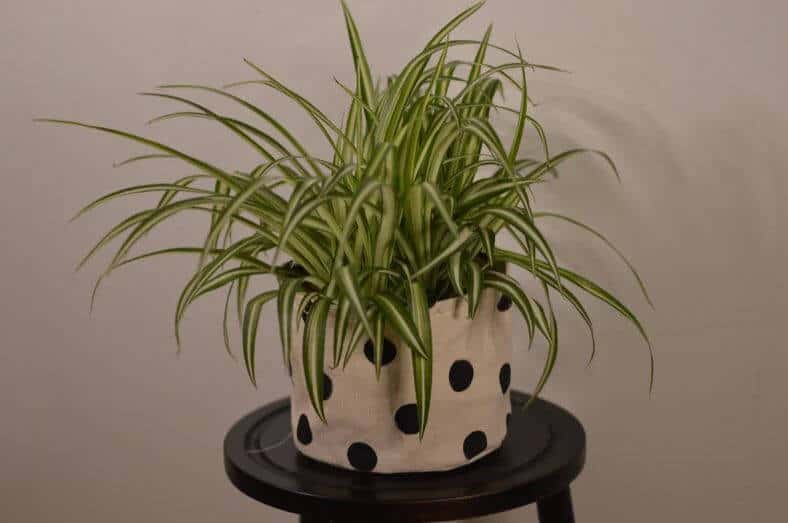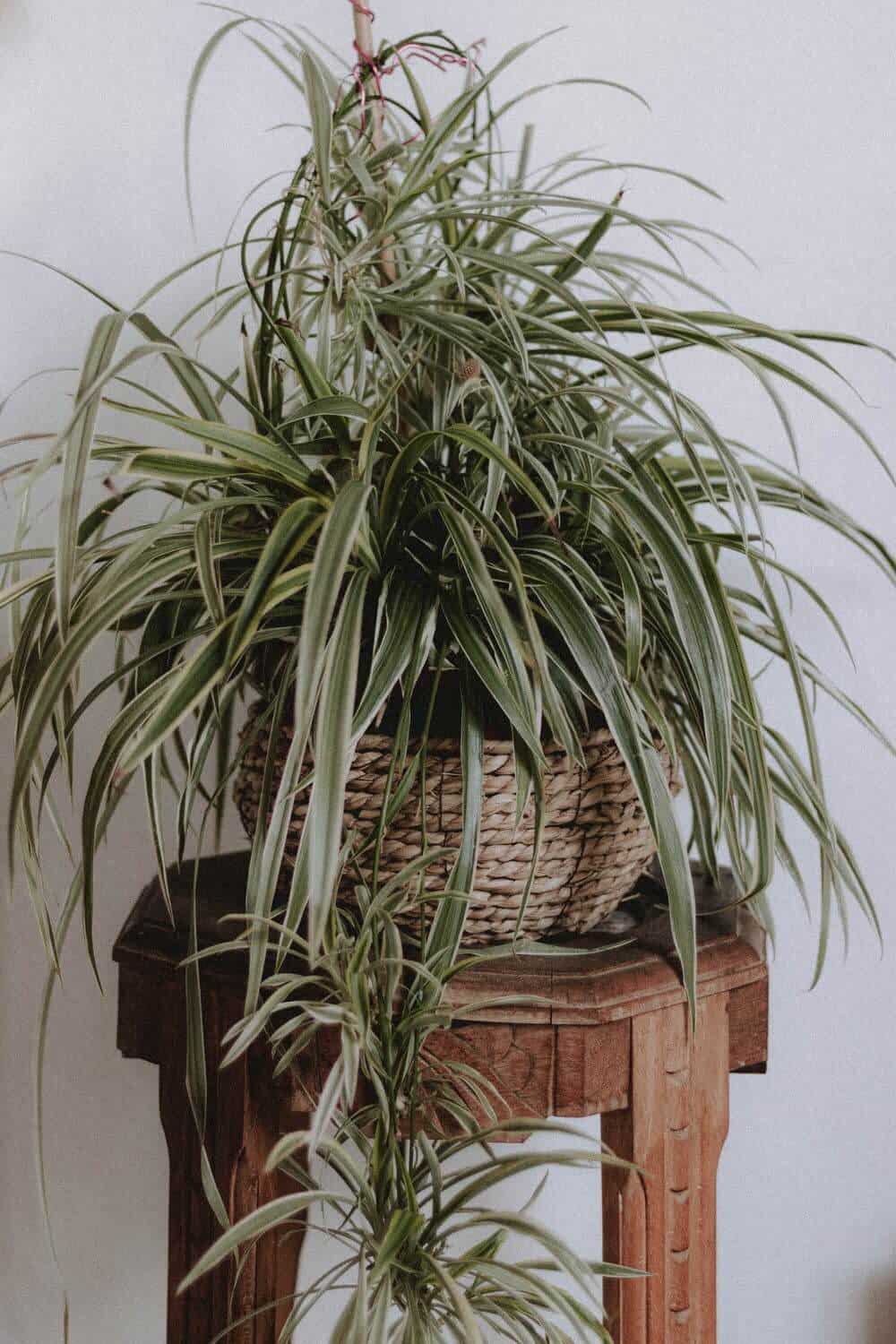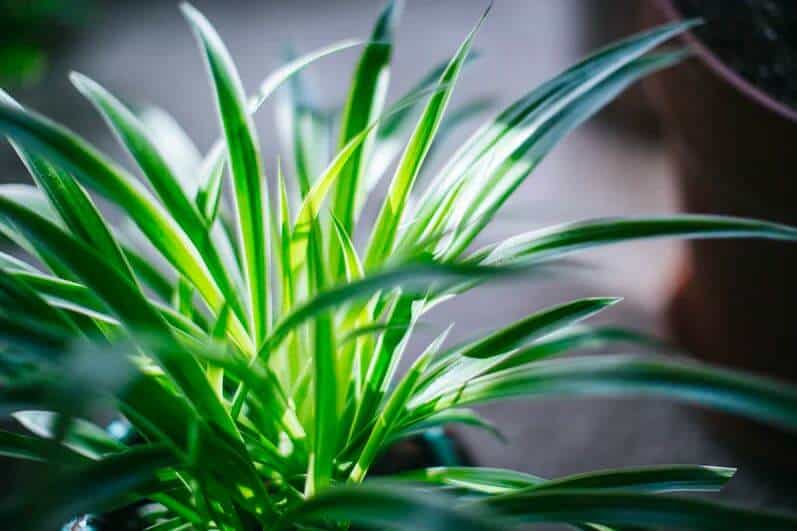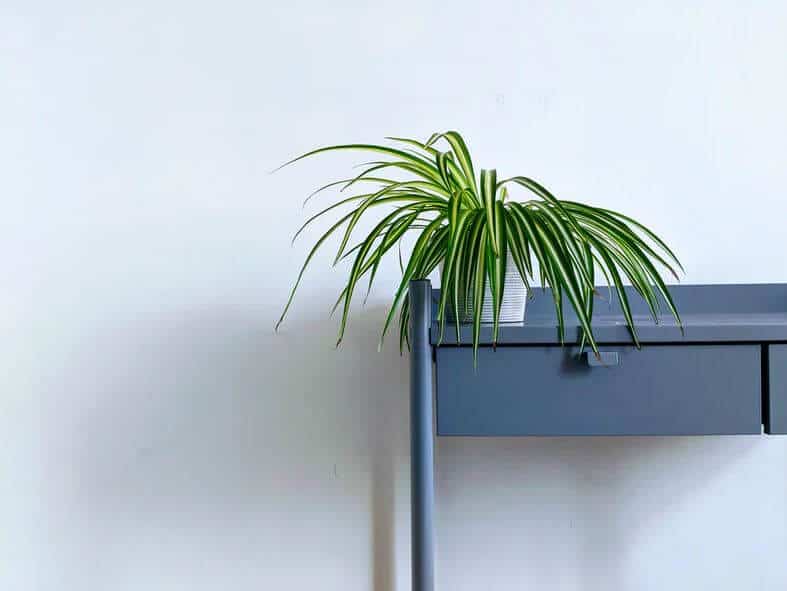Last Updated on February 8, 2023 by a Friendly Gardener
Although this plant boasts no direct relationship to arachnids, nor is it in some way particularly attractive, its name might imply otherwise. The Chlorophytum comosum takes its popular name from its cascading stems filled with wiry leaves.
A native of South Africa, this herbaceous perennial is a member of the Asparagaceae family. Well-loved as a decorative houseplant, it is also referred to as the ribbon plant, airplane plant, Bernard’s lily, or Spider Ivy. A hardy plant, it manages even when environmental conditions are not the best.
Elegant arching leaves will grow to lengths of 1.5 feet and are generally green and white striped, or just green. Mature plants will flower producing longish stems with tiny star-shaped blooms. When the blooms fade and die, in their place baby plantlets will form and each plantlet then grows its roots. Ideal for year-round cultivation, they are not frost-tolerant.
A Hanging Beauty

Most often Spider plants are cultivated in hanging baskets because of their cascading foliage and plantlets. Perfect for upper shelves, columns, or furniture of a certain height, it’s a good idea to keep an eye on the weight of stems and plantlets, so that plant containers don’t tumble over. These plants also do exceptionally well outdoors if you live in warmer climates.
A Hidden Talent
Years ago, NASA did a Clean Air Study. The spider plant is one of several houseplants that remove airborne toxins such as xylene and formaldehyde generally found in homes, so the presence of this lovely plant may be more than decorative.
Spider Plant Care

Soil
This plant will thrive in a variety of soil types but they prefer soil that is loamy and loose. As with so many houseplants, excellent drainage is a must. They prefer a neutral soil pH but manage in soil that is slightly acidic soil to slightly alkaline, so there’s a bit of flexibility. Ideally, the pH level should measure between 6.0 and 7.2. When the soil contains too many salts, you’ll probably see brown tips. If grown in an outdoor garden, give them roughly three feet of growing space.
Light
Spider plants prefer partial shade outdoors. They will tolerate total shade, but growth will be slower. Light exposure must be indirect to avoid scorching leaves. Indoor window positions with indirect sunlight are best. Too much direct sunlight may encourage green leaves with yellow striping. Too little light will cause leaves to droop. In warmer climates without frost risk, spider plants are an attractive ground cover as long as the location features filtered sun.
Water and Humidity
The spider plant prefers moist soil. Overwatering the plant can cause root rot eventually killing it. Spider plants are sensitive to both fluorides and chlorine. If your municipality has high levels of either in your tap water, opt for distilled water or collected rainwater. These chemicals can cause brown tips on leaves. Water moderately and in the growing season during the spring and summer, the soil needs to remain moist to encourage growth. Container soil should not be permitted to dry out totally.
When humidity is low, foliage tips may also turn brown. Misting can help. Steamy bathrooms are a great option or you can use a space humidifier, pebble tray, or group plants together to raise location humidity.
Temperature
Temperatures should not fall below 50° Fahrenheit, as your Spider loves warm, humid spots. Also, protection from cold drafts and air conditioning vents or heaters is recommended. The best daytime temperatures will measure between 65° F and 85°F. while at night 50°F to 55°F is fine.
Feeding
Light fertilization will be appreciated. With too much, leaf tips will turn brown, and too little will affect growth. Feed your Spider twice a month during its growing season with a quality liquid fertilizer diluted to half-strength.
Pruning
Spider plants can grow up to three feet in diameter and length, so it’s okay to prune some plant foliage at the base. Prune in the springtime to keep the plant’s size manageable and to encourage growth. You can also remove plantlets at this time. Baby“spiderettes” will cause a plant to require more water and fertilizer.
Trim at the plant’s base with a sharp pair of sterilized scissors and remove dead or damaged foliage. Baby spider plants can be removed by cutting long stems back to the base in both parent and baby plants.
Spider plants form crowded mounds of foliage, so thinning can help prevent overcrowding. When the plant is mature and somewhat root-bound, plantlets will begin to grow. Constant thinning will impede plantlet growth.
Repotting

When repotting, trim the roots. This should be done annually or every other year before repotting.
Choose a new pot with drainage holes that is slightly bigger than the root ball. Your spider plant should be repotted every 2 to3 years or when roots peek from drainage holes or the soil bed surface.
When repotting, do so in the spring at the beginning of the growth period. Remove your plant gently and position it in a new pot at the same depth. Fill in the remaining space with fresh soil.
Pests, Diseases, and Problems
This is a healthy and resilient houseplant. It is susceptible to pests common to most houseplants including aphids, whiteflies, scale, and spider mites! If the foliage looks as if it’s suffering, you may have an infestation. Tiny black spots on foliage undersides or stems also point to pests, as well as the curling or stunting of leaves. Small brown bumps on stems that can be scraped off with a fingernail are scale insects, while sticky residue on foliage is honeydew indicating a sap-sucking pest such as aphids, scale, or mealybugs. Shower your spider plant to remove pests. You can also use organic insecticidal soap or Neem oil to treat your plant.
It is easy for this plant to become root-bound, as it is a rapid grower. Brown leaf tips are a telltale sign that something is off. They can be caused by dry soil, low humidity, or too much salt and chemical buildup. Brown tips should be trimmed. Trimming them will in no way damage your plant.
Use a soft moistened cloth to clean pests, dust, or debris from foliage, Do leaf undersides as well.
Outdoor Spider plants will crowd other plants if there is no barrier to impede this.
Spider Plant Toxicity
The Spider plant is non-toxic to cats and dogs.
Spider Plant Propagation

The spider plant facilitates propagation because it will grow baby plantlets. Leave these spiderettes on their stems until roots develop. Once roots have developed, cut the plantlet off the stem with the roots intact. Put each plant in a new container. Soil should remain moist without becoming soggy. The new roots will eventually establish themselves in the soil bed.
Another option is to place a new pot of soil alongside the plant. The baby plantlets should be able to touch the new soil. Keep the new pot with the soil moist. Once the baby has rooted in the soil of the new pot, snip its connection to the parent plant. Spider babies can also be rooted in water before transplanting.
Mature Spider plants can be propagated through division. Gently remove them from the soil bed and divide the root ball into two or more clumps. Roots must remain intact. Replant the divided clumps in individual containers.
Final Considerations

A spider plant is a low-maintenance houseplant that is particularly suited for beginning gardeners. Spindly and green, they will bring cascades of color, to any décor. The graceful arching leaves are beautifully showcased when cultivated in hanging baskets or positioned in high spots to permit their naturally cascading growth.

